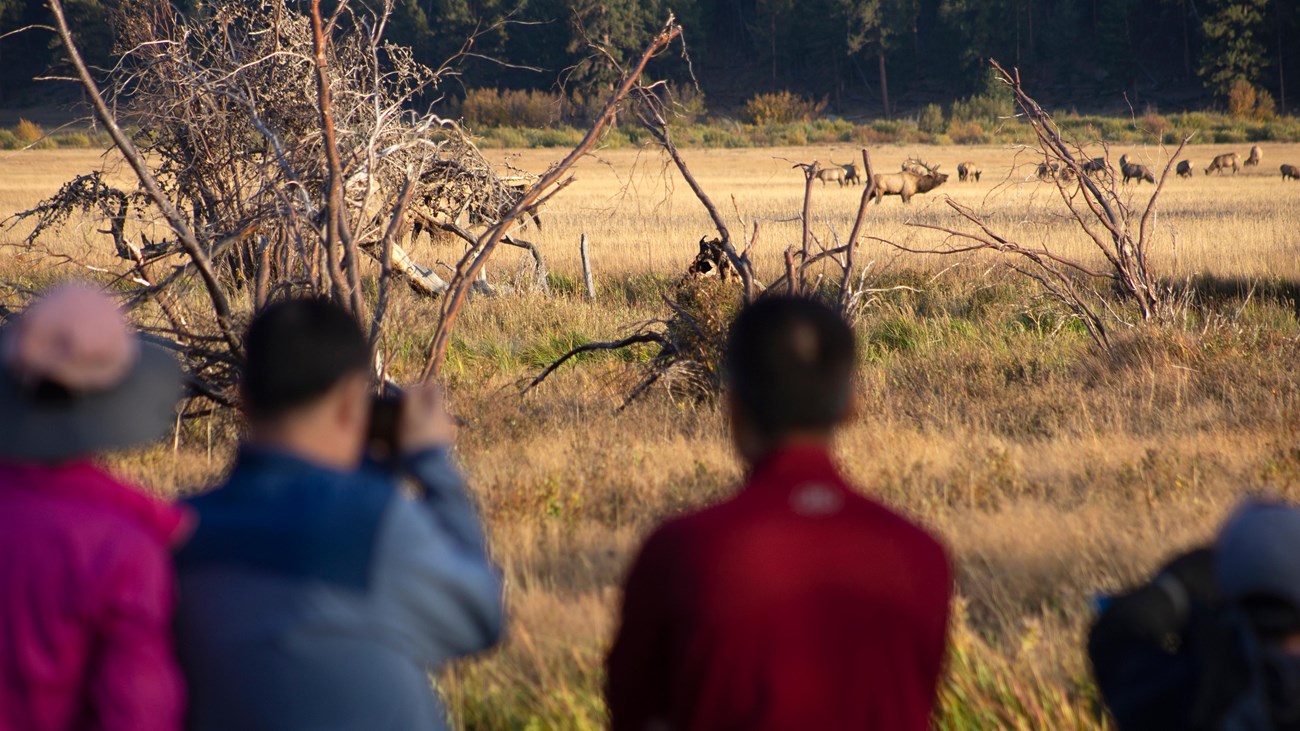Last updated: September 22, 2022
Thing to Do
Watching Elk

NPS Photo/Grossman
Elk Viewing and Meadow Closures
During the months of September and October, elk herds are gathering in lower elevation areas for fall mating season. This time is also known as the elk rut! Bull elk can be very aggressive as they protect the cows and young in their herd.
When your friends ask, “How close can I get to that elk?" suggest they ask a different question, such as “How far should I stay back?” Let wildlife be wild and observe from a distance. Stay back at least 75 feet (or two bus lengths). Let your friends know that approaching wildlife is illegal in Rocky Mountain National Park and it doesn’t matter if they are doing it to take a photograph.
To help prevent disturbance and harassment of elk during this time, and to enhance elk viewing opportunities for all park visitors, from September 1 to October 31, areas in Horseshoe Park, Moraine Park, Upper Beaver Meadows, Harbison Meadow, and Holzwarth Meadow are closed to all foot travel from 5:00 p.m. to 10:00 a.m. daily. Park visitors must stay on designated roads or established trails during this time.
Fishing locations found within these areas along sections of Fall River, Big Thompson River, and Colorado River are closed to all anglers from 5:00 p.m. to 7:00 a.m.
Where can I view elk?
Elk can be seen at locations througout Rocky. Always keep your eyes open. Popular wildlife viewing locations include Moraine Park, Sheep Lakes, along Trail Ridge Road, Horseshoe Park, and Harbison Meadow.
North American Elk (Cervus canadensis)
Elk are one of the largest members of the deer family. Large males, called bulls, can weigh up to 700 pounds and stand five feet at the shoulder. Females are called cows, weigh up to 500 pounds, and are only slightly smaller than bulls. A dark brown mane, light-brown bodies and white rumps characterize both sexes. Only males have antlers, which grow in the spring and drop each winter.
Life History
Elk are highly social animals and herds can grow to as large as a few hundred individuals. Elk have a large range and move according to seasonal food availability. In the summer, herds move to higher elevations to feed on tundra vegetation, while in the winter they move down to lower elevations of the park and down into the foothills of the Front Range. Large herds consist of cows, calves and young bulls (spikes). Older bulls remain in smaller groups, or are solitary, until the fall breeding season. Elk primarily graze on grasses and forbs but will also browse shrubs. They feed mostly in the morning and evening and seek sheltered areas during the middle of the day to digest. They eat an average of 20 pounds of vegetation daily. Free roaming elk have a lifespan of 10-13 years in the wild.
Help Us Protect Rocky's Elk
To minimize disturbance to the animals and to ensure a pleasant experience for visitors:
- Turn off car lights and engine immediately when parking.
- Keep it quiet. Shut car doors quietly and keep conversations to a minimum.
- Keep your distance. Observe and photograph from a distance comfortable to the elk. As a rule of thumb, always maintain two school bus lengths (75 feet). If the elk move away or their attention is diverted: you are too close!
- Be aware of posted area closures. Stay by the roadside while viewing elk in park meadows. Travel is restricted to roadways and certain designated trails.
- Do not disturb the elk. It is illegal to use artificial lights or calls to view or attract wildlife.
- It is illegal to approach, harass, or feed wildlife. Animals that learn people are a source of food can become aggressive or stop hunting or foraging on their own. Keep your distance - it's the law! You could be hurt or issued a fine.
Timed Entry Permit Reservations are required to enter Rocky Mountain National Park between May 27 and October 10, 2022
Timed Entry Permit Reservations are in effect from 9 a.m. to 3 p.m. for all areas of the park outside of the Bear Lake Road Corridor. To visit destinations along Bear Lake Road, like Bear Lake, Sprague Lake, and Moraine Park, Timed Entry Permits are in effect from 5 a.m. to 6 p.m. daily.
Permit holders must initially enter Rocky Mountain National Park during their 2-hour entrance window. If you have a Park Access + Bear Lake Road Timed Entry Permit, you must enter both the main entrance to the park and the Bear Lake Road entrance within your reserved 2-hour entrance window. This means that if someone books a Timed Entry Permit for 7 a.m. - 9 a.m., they must enter Rocky Mountain National Park within this window of time.
For more information, visit https://www.nps.gov/romo/planyourvisit/timed-entry-permit-system.htm. To book your Timed Entry Permit, visit https://www.recreation.gov/timed-entry/10086910.
